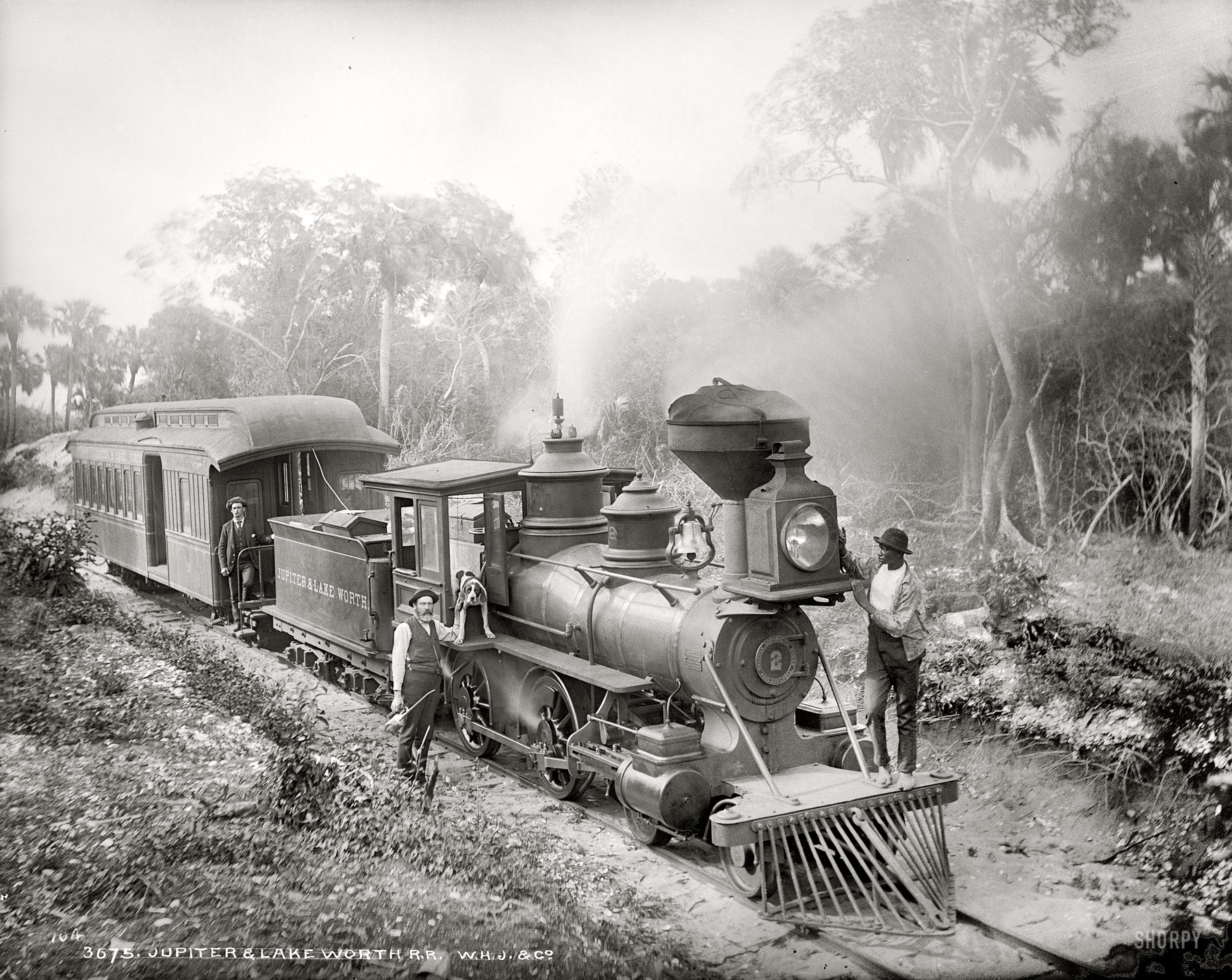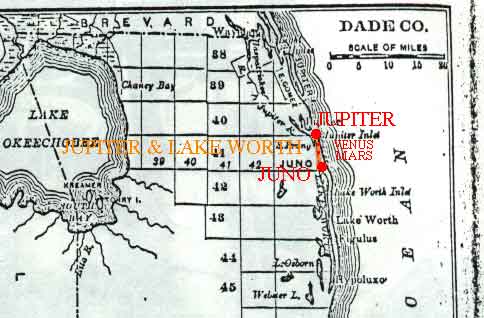TAPLINES
The Jupiter and Lake
Worth Railway
"The Celestial Railroad"
February 6, 2000
All images and text copyrighted
2000 by Donald R. Hensley, Jr.
revised Sept 28, 2009

Jupiter
and Lake Worth number 2 somewhere on line. Blus Rice the engineer will
be oiling the locomotive as soon as he finishes scratching the head of
his bird dog, Blue, whom he rented out to passengers for hunting along
the rail line. Blus would stop at choice hunting spots and would leave
the hunters with Blue, and on his return trip he would blow his whistle
and Blue would return his charges back to the railbed. Blus greeted his
passengers by playing "Dixie" on his whistle when he arrived at the wharf.
On the pilot is the fireman, Milton Messer. On the combination car is Captain
Matheson, the conductor. The original photo is in the Library of Congress.
The Celestial Railroad
The Jupiter and Lake Worth was built and owned by the Indian River Steamship
Co. as a portage line connecting the Indian River with Lake Worth in what
was then Dade County, Florida. The steamboat company was in turn owned
by the Jacksonville Tampa and Key West Railway which connected with the
steamboats at Titusville, Florida on the Indian River 120 miles north of
Jupiter Inlet. Construction began in October of 1888 and was completed
by June of 1889, just in time for the Fourth of July. To mark the occasion
the little road gave the local folks a free ride to Jupiter for the big
picnic and celebration.
The railroad was known as the Celestial Railroad
with its four stations dubbed Jupiter, Venus, Mars and Juno. Jupiter was
located at Jupiter inlet on the southern most point of the Indian River
and was the headquarters for the road. The Indian River is not a river
but actually a 150 mile long salt water lagoon which has three natural
inlets to the ocean. At Jupiter the J&LW connected with the Indian
River Steamboat company and interchanged freight and passengers. The railroad
had a wharf, freight and station house, run around track and a storage
track at Jupiter. The offices of the railroad and steamship company were
located in Jupiter along with a floating hotel, an old retired steamboat.
Venus and Mars were only loading platforms on
a siding. Juno, eight miles out from Jupiter, was located on the northern
tip of Lake Worth (actually another salt water lagoon) where the railroad
connected with the Lake Worth Transportation Company and its steamboats
that served the small towns to the south. Juno was elected as the county
seat of Dade County in 1889 because of the railroad terminal. A wharf and
freight house with a run around track were located here.
Equipment for the J&LW came from its parent
railroad, the JT&KW. At that time the JT&KW operated the Key System,
a large system of railroads in Florida. This system operated at one time
four narrow gauge railroads: The Florida Southern, the Jacksonville, St.
Augustine & Halifax, the St. Johns & Halifax and the St. Johns
& Lake Eustis. Equipment to the J&LW consisted of hand me downs
from these roads. The
J&LW owned two locomotives, both Baldwins with rare recatngular plates , two combination baggage and passenger cars,
two flat cars and one box car.
Regular operations consisted of four trains a day,
except for Sunday when only two afternoon trains were run. Trains were
normally operated as a straight passenger run with just one combination
car for the passengers, mail, light freight and express. When freight traffic
was heavy enough, freight cars would be added making it a mixed train.
As the road operated in the tropical part of Florida, northbound traffic
consisted of coconuts, pineapples, dates, citrus, sugar cane, turtles,
fish and early vegetables. Southbound traffic included building materials
and merchandise.
There was no way to turn
trains on the J&LW, so the locomotives always faced southbound toward
Juno. Northbound runs to Jupiter were made backwards. Local citizens had
to look twice at northbound trains as it appeared that the cars were pulling
the little engine. Trains would stop for anyone flagging it down from the
bushes and it has been said that complaints were heard that the crew would
visit often and long with friends during the scheduled run.
The end came when Henry
Flagler's Florida East Coast Ry bypassed the little line on its way south
to Palm Beach and later on to Miami and Key West. Flagler wanted to buy
the little J&LW, but the JT&KW wanted him to buy not only the J&LW
but also the steamboat company that would be put out of business by Flagler's
trains. But Flagler, who always built his hotels before the arrival of
his railroad, needed the J&LW to carry the building material for the
Breakers Hotel at Palm Beach. The railroad made a small fortune hauling
this material, and they made more money than they would have received from
Flagler. The end came in April of 1895 when the Florida East Coast reached
Palm Beach putting the Indian River Steamship Company and the Jupiter and
Lake Worth out of business. The rolling stock was sold at auction in Jacksonville,
Florida in June of 1896.

Jupiter and Lake Worth number one with three little
girls from the Doster family who had a store on the dock. Photographed
at Jupiter. Original photo is in the Library of Congress, this one is made
from a copy negative from H.C. Dubal and is now collection
of Don Hensley.


RETURN TO TAPLINES



